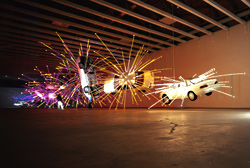Former Seattle artist James Jaxxa now lives in Manhattan, where he has a studio in Chelsea. He has contributed to Zeitgeist’s Shrinky Dinks Invitational for the past three years. This year, he made a sculptural garland of pink flowers. Sue Peters asked him about the unique challenges of working with such an unconventional medium.
Seattle Weekly: What prompted you to contribute to this show?
James Jaxxa: Conceptually, I love the idea of a Shrinky Dink show. I’m attracted to the material because it has properties similar to the materials I use in my artworks. The show is also for a good cause.
What kind of art do you normally make?
I create objects, site-specific installations, and photographic works. I enjoy working with bright, glittery, and shiny materials to expose latent possibilities in the commonplace—bridging the disparity between the playful abandon of youth and the seriousness of the adult world.
What are the unique challenges and the advantages of working with a medium such as Shrinky Dinks?
Typically, the price of an artwork is based on size. When working with Shrinky Dinks, as an artist, you have to accept the fact that you create something that starts out large (and usually more expensive) and that it shrinks down to something smaller and less valuable. A $500 painting shrinks down to a $50 painting before your very eyes. As an artist, it is quite shocking to see the shrinking happen. As a child, you think of Shrinky Dinks as toys, not in terms their dollar value.
You have worked with various interesting media already. Had you ever worked with Shrinky Dinks before? Did you play with them as a kid?
Yes, but I always remember being disappointed with the results. I would either color the material too heavily, causing it to look too dark (and ugly) after it shrank, or I would be unhappy that the material didn’t shrink evenly or without curling. And I participated in two other Shrinky Dink invitationals at Zeitgeist when I lived in Seattle.
For your Shrinky Dink Invitational piece, did it take many tries to get it right?
I have learned from working with the material in the past that it’s good to experiment with my idea and the material before I try to execute it. For this piece, I worked with Shrinky Dink scraps twice before creating the final piece. The first time, the color was too dark. The second time, I found the material didn’t shrink enough, so I had to cut smaller pieces (flowers) to create the effect I was looking for. After these two experiments, I was very pleased with the third result.







